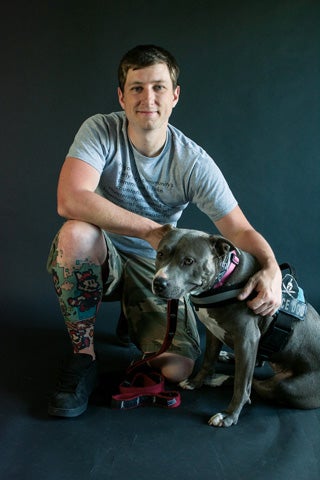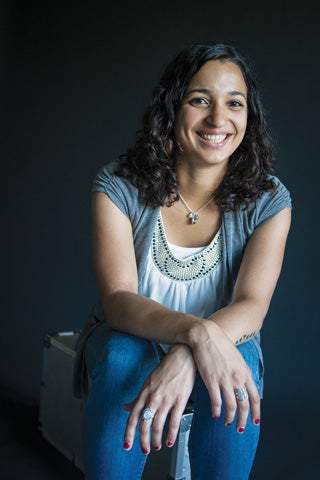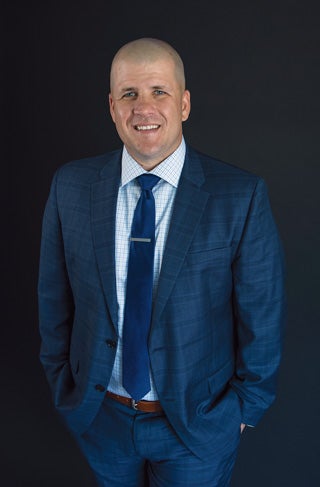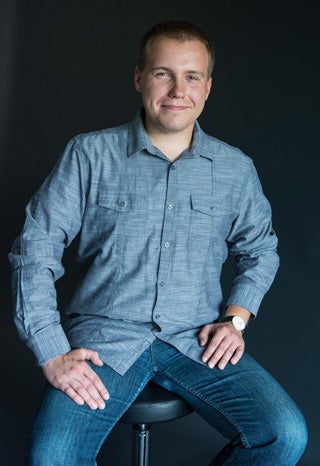U.S. colleges, including the University of Rhode Island, are seeing the biggest influx of military veterans since WWII. But soldiers adjusting to civilian life don’t always find school a welcoming place. Student activists are shedding light on the services—and sense of camaraderie—that could make a difference.
By Ellen Liberman
“When I was in the Army, I was in charge of six-million-dollar vehicles—and lives. I get out, and I’m not qualified to make a latte.” —Chad McFarlane, 32, who spent five years stationed at Fort Stewart, Georgia, serving two tours in Baghdad. He was homeless for a time before moving to Providence. The veterans advocate has served on numerous committees, including the Rhode Island Military Organization, a support group that hopes to create a military lounge at T.F. Green Airport, and has worked as a veterans affairs coordinator in Congressman David Cicilline’s office. Among his civilian and military honors, McFarlane received an Army Commendation Medal and two Army Achievement Medals, and was CCRI’s 2014 student commencement speaker. His research examines the economic cost of allowing veterans’ skills to go untapped.

It was just after dawn, and rounds were coming from every direction. Alex Reppe ’16, a sniper with the U.S. Army’s 101st Airborne Division, was hunkered over his M24 bolt-action rifle on the roof of a house in Yahya-Kheyl. The small Afghani village in the southeastern Paktika province was a portal for Taliban fighters who crossed the border from their training camps in Pakistan to use American soldiers for target practice. Reppe had positioned himself onto the rooftop in the middle of the night with his team leader, Matt Moore, and another sniper, Mitch Ellison, on a mission to ambush the enemy. But someone had seen them. Barely half an hour after their position had been compromised, the team was pinned under fire.
Reppe, who had never touched a gun until he joined the U.S. Army in 2007, became a sniper because “the professionalism of the snipers always attracted me—to be calculated in the battlefield amid the confusion—it seemed really interesting.”
Miscalculations, on the other hand, were risky. The team returned fire, but the bullets striking the rooftop told Reppe that the Taliban was closing in. His leader took some shrapnel in the face, screamed and jumped off the roof. Reppe prepared to do the same.
The Taliban favor sniper rifles and the cheap and hardy AK-47; both use M43 projectiles that have a reputation for superior penetration and bodily damage. This one grazed the back of Reppe’s face, passing through his helmet and cheek, breaking his orbital bone and nose before exiting. Reppe passed out and dropped to the courtyard, 12 feet below. When he woke, “blood was flowing crazily over my gear. I was so confused, I didn’t know what happened.” Ellison looked down at him and swore, “Oh f***.”
“I knew that couldn’t be good.”
Reppe pauses in his account to stroke the flank of his service dog Icey, a gregarious, smoke-gray pit bull absorbed in the obliteration of a chew stick. Some veterans don’t tell war stories—because they aren’t just stories. But Reppe doesn’t mind. He recovered from his physical wounds, and a casual observer would find no trace of the bullet that ruptured his face in November 2010. Three months after being wounded, he re-joined his company until his tour ended in 2012. He’s telling this story in the rear of the empty Memorial Union, just before graduating with a double major in anthropology and psychology. He also told it for a public speaking test in a communication class.
“But I don’t bring my military experience up very often,” he says. “Most people don’t think anything of it. I think a lot of people are afraid to ask, and some people just don’t care.”
Today’s 18-year-old freshmen were building towers with blocks when the Twin Towers fell and the U.S. invaded Afghanistan. They were 4 years old in 2003, when the U.S. started a war in Iraq. With one Navy and two Coast Guard bases, the military does not have a large footprint in Rhode Island. Reppe perhaps overstates the apathy, but the disconnect between the University of Rhode Island and its student veterans has been a challenge that the former and the latter have been working together for the last three years to address.
In May, Interim Vice President for Student Affairs Mary Jo Gonzales made a “compelling case” before the Strategic Budget Planning Council to create a full-time student veteran coordinator position quartered at the Kingston campus. This fall, the Student Veteran Center will open, unveiling a newly kitted-out gathering space and resource center in the lower level of Adams Hall.
“We as a campus needed to be more educated, and in the past year we attempted a joint student veteran coordinator position at the Providence and Kingston campuses to figure out the real needs of student veterans. We know that there is a strong need for holistic support services,” Gonzales says.
For example, the vet who just completed multiple combat tours in Iraq may need disability services to obtain academic accommodations for a traumatic brain injury. The vet entering with a clutch of previous credits may need help getting a URI program to accept them. The vet entering with a weak high school record may need tutoring to handle college-level academics—or any combination of these services.
The University needs to create one place “to serve as the center of that wheel and provide the appropriate wrap-around services so students don’t have to go from office to office to office,” Gonzales says. “But this is a national conversation. It is not unique to the University of Rhode Island.”
In the last decade, U.S. institutions of higher learning have seen the largest influx of military veterans since 2.2 million GIs returning from World War II went to school on the Servicemen’s Readjustment Act of 1944. Last year, the U.S. Veterans Benefits Administration reported that more than one million military veterans or their dependents were accessing federal education benefits.
But the first wave of vets transitioning from Operation Enduring Freedom (the conflict in Afghanistan) and the Iraq War found that most colleges were not equipped to meet their needs, and that the then-current Montgomery GI Bill had not kept pace with rising tuition, says Walter Tillman, vice president of programs for the Student Veterans of America. In 2006, a small group of student veterans got together to lobby Congress for better education benefits and their schools for better services. In 2008, what is commonly known as the Post 9/11 GI Bill was signed into law and the Student Veterans of America (SVA) was officially established. The organization now boasts 1,300 chapters nationwide.
“The experience of student vets varies drastically depending on where they go to school,” Tillman says. “Some campuses create very welcoming environments to ease that transition; others don’t do as great. But most are trending in the direction of creating more robust services, especially when you have students organizing to provide that user-level feedback.”
According to the U.S. Department of Veterans Affairs, 2,416 veterans were using their education benefits in Rhode Island last May, 374 of them at URI. As a group, they are older than most students, generally ranging in age from 22 to 29. They are 75 percent male and 25 percent female, coming from every branch of the service. Annually, they bring $1.9 million in revenue to the University. Many have spouses, children and a sharply defined career focus. They are, as Gonzales describes them, “mission driven.”

For some, the move from the military to URI is nearly seamless. Last year, Navy vet Lisa Garcia ’17 followed her boyfriend, who teaches firefighters at the Newport Naval Station’s Officer Candidate School, to Rhode Island. Garcia found a perfect fit for her ambitions in the University’s biotech program, where she studies “how medicines work in the body,” with an eye on a master’s degree and a career in research. The program accepted the 56 credits she earned from Skagit Community College and courses she took while working as a machinist on an aircraft carrier. And she found a work-study job at the Veterans Affairs Office on URI’s Feinstein Providence campus.
Socially, it was often awkward, being surrounded by undergraduates glued to their phones or chatting about topics far removed from Garcia’s experience or interest. There were few other veterans, and she wasn’t one to “boast about being in the military,” she says. “It makes me shy.”
Then there is the military code of stoicism and the habits it can instill. “It’s hard to ask for help,” Garcia says. “I broke my leg on the ship and they said that they couldn’t do anything for me because we were in the middle of operations. So they wrapped it and I walked around like that for six weeks. Suck it up, buttercup. That’s how it is in the military.”
That tendency to quietly soldier on was one reason why veterans had no organized presence on campus when Don Ruggieri ’15, a Marine who served in Iraq, entered URI in 2011.
“I was shocked that URI didn’t already have a chapter” of SVA, says Ruggieri, who founded one in 2012 and graduated with a bachelor’s in animal and veterinary science. “I thought, I can’t be the only student veteran on campus. I wanted to create a place to talk with other people who had the same experience I had.”
He eventually worked with Lucas Marland ’16, then a sophomore and an active-reserve Coast Guard chief petty officer, to join staffers from departments across campus on the URI Supports Student Veterans Committee. The committee tackled matters large and small, practical and cultural. For example: Students’ habit of parking their motorcycles at the concrete base of the flagpole by the Memorial Union rankled Marland.
“That’s not a parking space,” he says. “It’s disrespectful.”

The administration agreed, posting a no parking sign and ticketing violators. But getting an official meeting space for the fledgling group proved much more difficult. The 73-year-old student union began in a fraternity house, then moved to five Quonset huts. In 1954, the first official Memorial Union building opened, dedicated as a memorial to 187 members of the URI community killed in World War II and the Korean conflict. Despite its origins as a monument to veterans, the Union had no space for SVA’s URI chapter, save for a closet-sized room. It took three years of pushing before the University secured a space in Adams Hall.
“They kept telling us ‘No no, no.’” Ruggieri recalled. “But in the last year they have reversed course and are doing so much more, it’s mind-boggling.”
Student veterans have always found strong support at Enrollment Services, where staffers Roy I. Jones, a veteran who also served on the support committee, and Sharon Lee Charlton certify to the VA each semester that individual veterans are using education benefits and housing allowances properly.
“It gives us a chance to meet with them regularly and find out how it’s going—and get a sense if they are in trouble,” Jones says. “If there’s a hesitation, or a look on their face, you know that something is up.”
They may steer veterans to Pell grants or refer them to tutoring or disability services. Last year, at least 16 student veterans were receiving academic accommodations, like extra time taking tests, but Pamela A. Rohland, assistant dean for accessibility and inclusion, suspects that twice as many are eligible and would benefit from disability services.
“When it comes to being in the service, disability at the outset is an exclusion. It’s a reason to be discharged,” Rohland says. “In college, disability is a way to be included and have an equal opportunity for success. But a lot of veterans hesitate to identify themselves to us, even though it’s confidential.”
Meanwhile Ruggieri and Marland looked for veterans on campus missing the camaraderie of service. The SVA chapter started with four members; Marland would scan the Quad looking for people carrying an Army backpack, wearing a Navy T-shirt, or walking with a military bearing, hoping to persuade them to join the group. Many, it turned out, weren’t interested.
“They just want to go to school and get it done,” Marland says. “But a lot of them need a friend, a guide or an advisor—someone to make their transition into the school easier.”
Chad McFarlane ’17, on track to graduate with a degree in applied economics, is examining what happens when vets don’t get the support they need. “What is the cost of a non-maximized veteran?” he says. “I want to study the economic impact.”
“The government invests the time and funds in training you, and you leave and you’re told that with your basic skill set, you’d be a great mechanic, security guard or janitor.”
His route to URI was circuitous. During 2003 and 2005 tours of Iraq, Sgt. McFarlane was a tank gunner until he was medically discharged after a motorcycle accident that shattered both his knee and his plans to re-enlist. He worked in Florida as a mail carrier in a neighborhood so bad, he jokes, “I got shot at about as much at the Post Office as I did in Iraq.”
McFarlane eventually moved to Rhode Island to be with family, and enrolled at the Community College of Rhode Island with the goal of becoming an engineer. But the math was difficult and he was academically unprepared. He failed his first semester, but persisted, and entered URI in 2014 while still slogging through an engineering program. A stint as president of CCRI’s SVA chapter, however, had ignited an interest in studying the economics of veterans. And at URI, other veterans and veteran advocates helped clear his path, connecting him to disability services and academic coaching, and encouraging him to reach out to his professors.
“I’ve been assessed for PTSD and they are tracking me for a traumatic brain injury. It’s hard to deal with the wounds of war on top of being dropped into this isolating environment,” he says. “But I started using services last year to get myself on track. It put me on firmer ground.”

in Scituate, R.I., feeling that “service is part of what people should do.” That feeling owes much to a father who served as an infantryman in Vietnam and whose best friends are fellow veterans. Steiner traveled all over the world during his station on the USS Nimitz.
This is the network of support and caring that current student veteran activists hope to build upon. And here’s where they’ll do it: On a May afternoon, Michael Steiner ’19 unlocked the door to the still-unfinished Student Veterans Center. It’s the little patch of campus they fought for, complete with gray cinderblock walls, ceiling-height windows, a conference table, a couch and some chairs, and a dehumidifier humming loudly in the corner. No, a basement room in a freshman dorm wasn’t ideal, especially for adult learners, some of whom have PTSD. But, Steiner and Marland say, it will do for now.
“We aren’t a group that needs to have our hands held, but the military gives you that sense of family that you don’t have on the outside,” Steiner says. “That’s why we get together on campus—to try and foster that.”
Steiner, who served in the Navy from 2005 to 2011, is the URI SVA chapter treasurer. An economics major, he also had a few challenges adjusting from regimented military life to the “burden” of choice as a civilian. But he found a sense of purpose in helping other veterans navigate the nuances of GI Bill benefits, and in raising the SVA’s profile on campus. The chapter now has about 30 members, and Steiner plans to continue lobbying for space in the Memorial Student Union and for the installation of another bronze plaque, this one dedicated to all veterans.
“You just have to be patient—what you plan on seeing might not happen in your tenure here,” Steiner says of the pace of change at the University. “But looking back, I see what we have accomplished. And I want to give back to a community that gave me so much.”
Alex Reppe was an indifferent student in high school; his first attempt at college only lasted three semesters. The Army taught Reppe how to study—one test failure could get you cut from a training program. And it gave his intellectual curiosity a focus. Living and working amid people with an ancient culture inspired him to learn more. He wasn’t a religious person, but his time in Afghanistan “made me question all of that. Every time people said someone’s watching over you, it really made me think.”
When you arrive at a combat zone, everyone’s scared, he says. Death is so close. A soldier’s first firefight is confusing and surreal. Battle eventually becomes a rush, then that fades, too. His injury stripped him of the feeling of being bullet-proof.
“It changes how you see combat,” he says, “and you feel shaky when you go back out.”
Those feelings followed him to URI, where anxiety and depression paralyzed him at times.
“It’s hard to process those traumatic experiences and once you’re out of the Army, there’s nobody who understands,” Reppe says. “You feel abandoned and lonely. It can get sad sometimes.”
Once, in the spring of his sophomore year, he got so depressed he didn’t go to school for three weeks, and turned an A-plus in a math class into a C-minus.
“I didn’t talk to my professors about it because I felt like it was my problem,” he says. “I didn’t want special treatment for being a veteran.”
But he powered his way through, acquiring Icey during his senior year, and graduated with honors. This fall he enters the University of Colorado at Boulder to pursue a master’s in religious studies, a stepping stone to a Ph.D. in cognitive anthropology. He didn’t walk at graduation here this May; he worked his regular shift as a line cook at Newport’s Salvation Café. He just wanted to get on with it.
Mission driven.•
 Home
Home Browse
Browse Close
Close Events
Events Maps
Maps Email
Email Brightspace
Brightspace eCampus
eCampus


